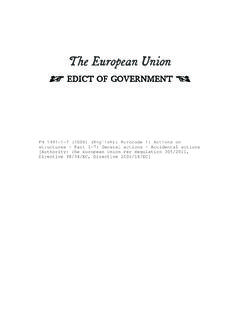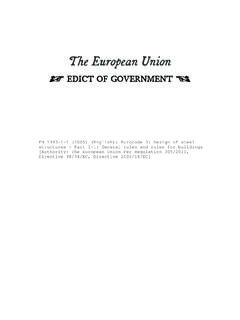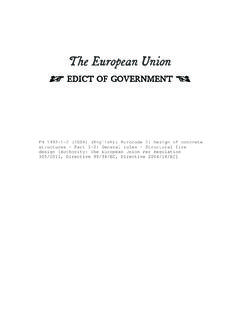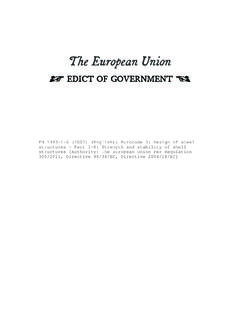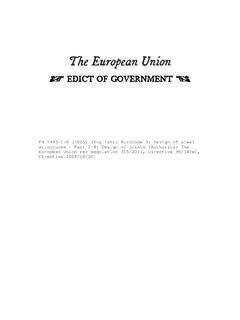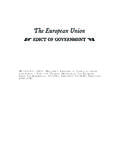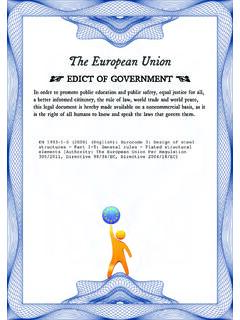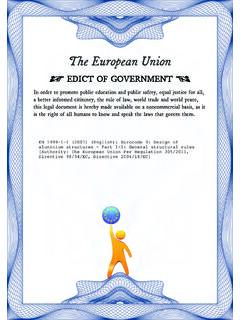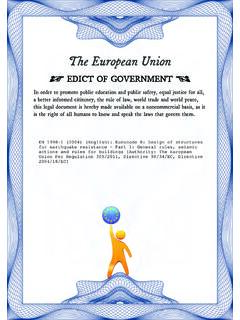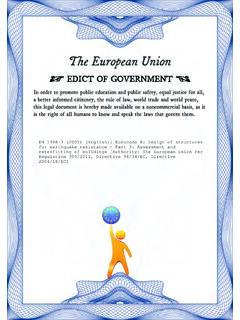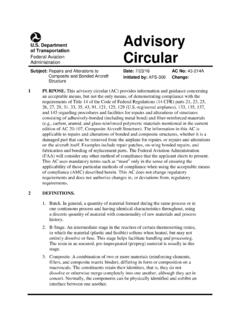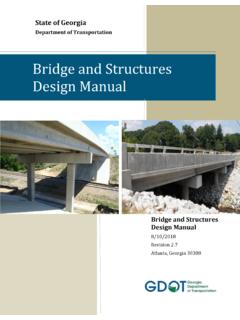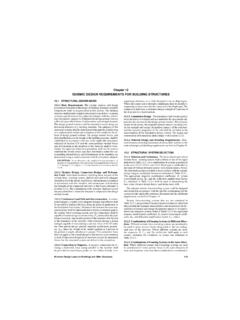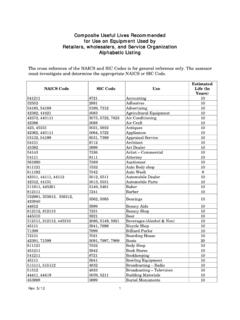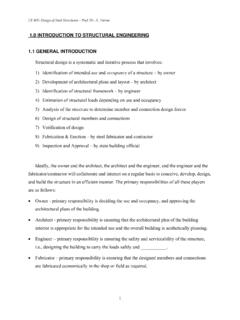Transcription of EN 1994-1-2: Eurocode 4: Design of composite steel and …
1 The European UnionIn order to promote public education and public safety, equal justice for all, a better informed citizenry, the rule of law, world trade and world peace, this legal document is hereby made available on a noncommercial basis, as it is the right of all humans to know and speak the laws that govern them. EDICT OF GOVERNMENT EN 1994-1-2 (2005) (English): Eurocode 4: Design ofcomposite steel and concrete structures Part 1-2: Generalrules - Structural fire Design [Authority: The EuropeanUnion Per Regulation 305/2011, Directive 98/34/EC, Directive2004/18/EC]EUROPEAN STANDARD NORME EUROPEENNE EUROpAISCHE NORM EN 1994-1-2 August 2005 ICS ; ; ; Supersedes ENV 1994-1-2: 1994 Incorporating corrigendum July 2008 English Version Eurocode 4 - Design of composite steel and concrete structures -Part 1-2: General rules -Structural fire Design Eurocode 4 -Calcul des structures mixtes acier-beton -Partie 1-2: Regles generales - Calcul du comportement au feu Eurocode 4 -Bemessung und Konstruktion von Verbundtragwerken aus Stahl und Beton - Teil 1-2: Allgemeine Regeln Tragwerksbemessung im Brandfall This European Standard was approved by CEN on 4 November 2004.
2 CEN members are bound to comply with the CEN/CENELEC Internal Regulations which stipulate the conditions for giving this European Standard the status of a national standard without any alteration. Up-to-date lists and bibliographical references concerning such national standards may be obtained on application to the Central Secretariat or to any CEN member. This European Standard exists in three official versions (English, French, German). A version in any other language made by translation under the responsibility of a CEN member into its own language and notified to the Central Secretariat has the same status as the official versions. CEN members are the national standards bodies of Austria, Belgium, Cyprus, Czech Republic, Denmark, Estonia, Finland, France, Germany, Greece, Hungary, Iceland, Ireland, Italy, Latvia, Lithuania, Luxembourg, Malta, Netherlands, Norway, Poland, Portugal, Slovakia, Slovenia, Spain, Sweden, Switzerland and United Kingdom.
3 EUROPEAN COMMITTEE FOR ST ANDARDIZA TION COMITE EUROPEEN DE NORMALISATION EUROpAISCHES KOMlTEE FOR NORMUNG Management Centre: rue de Stassart, 36 8-10508russels 2005 CEN All rights of exploitation in any form and by any means reserved worldwide for CEN national Members. Ref. No. EN 1994-1-2: 2005: E BS EN 1994-1-2: 2005 EN 1994-1-2: 2005 (E) Contents Page Foreword .. 5 Background of the Eurocode programme .. 5 Status and field of application of Eurocodes .. 6 National Standards implementing Eurocodes .. 6 Links between Eurocodes and harmonised technical specifications (ENs and ETAs) for products .. 7 Add itional information specific for EN 1994M 1 M2 .. 7 National annex for EN 1994-1-2 .. 1 0 Section 1 General .. 11 1 .1 Scope .. 11 Normative references .. 13 Assumptions .. 15 Distinction between Principles and Application Rules .. 15 Definitions .. 15 Special terms relating to Design in general.
4 15 Terms relating to material and products properties .. 16 Terms relating to heat transfer analysis .. 16 Terms relating to mechanical behaviour analysis .. 16 Symbols .. 16 Section 2 Basis of Design .. 26 Requirements .. 26 Basic requirements .. 26 Nominal fire exposure .. 26 Parametric fire exposure .. 27 Actions .. 27 Design values of material properties .. 27 Verification methods.. 28 General .. 28 Member analysis .. 29 Analysis of part of the structure .. 30 Global structural analysis .. 31 Section 3 Material properties .. 31 General .. 31 Mechanical properties .. 31 Strength and deformation properties of structural steel .. 31 Strength and deformation properties of concrete .. 33 Reinforcing steels .. 35 Thermal .. 36 Structural and reinforcing steels .. 36 Normal weight concrete .. 39 Light weight concrete .. 41 Fire protection materials ..42 Density.
5 42 2 BS EN 1994-1-2: 2005 EN 1994-1-2: 2005 (E) Section 4 Design procedures .. 43 Introduction .. 43 Tabulated data .. 44 Scope of application .. 44 composite beam comprising steel beam with partial concrete encasement ..45 composite columns ..4 7 Simple Calculation Models .. 51 General rules for composite slabs and composite beams .. 51 Unprotected composite slabs .. 51 Protected composite slabs .. 52 composite beams .. 53 composite columns .. 61 Advanced calculation models .. 64 Basis of analysis .. 64 Thermal response .. 65 Mechanical response .. 65 Validation of advanced calculation models .. 65 Section 5 Constructional details .. 66 Introduction .. 66 . composite beams .. 66 composite columns .. 67 composite columns with partially encased steel sections .. 67 composite columns with concrete filled hollow sections .. 67 Connections between composite beams and columns.
6 68 General .. 68 Connections between composite beams and composite columns with steel sections encased in .. 69 Connections between composite beams and composite columns with partially encased steel sections .. 70 Connections between composite beams and composite columns with concrete filled hollow sections .. 70 Annex A (INFORMATIVE) Stress-strain relationships at elevated tenlperatures for structural steels 72 Annex B (INFORMATIVE) Stress-strain relationships at elevated temperatures for concrete with siliceous aggregate 75 Annex C (INFORMATIVE) Concrete stress-strain relationships adapted to natural fires with a decreasing heating branch for use in advanced calculation models 77 Annex D (INFORMATIVE) Model for the calculation of the fire resistance of unprotected composite slabs exposed to fire beneath the slab according to the standard temperature-time curve 79 Fire resistance according to thermal insulation Calculation of the sagging moment resistance Mfi,Rd + Calculation of the hogging moment resistance Mfi,Rd-Effective thickness of a composite slab Field of application 79 80 82 84 85 3 BS EN 1994-1-2: 2005 EN 1994-1-2.
7 2005 (E) Annex E (INFORMATIVE) Model for the calculation of the sagging and hogging moment resistances of a steel beam connected to a concrete slab and EA exposed to fire beneath the concrete slab. 86 Calculation of the sagging moment resistance Mfi,Rd + Calculation of the hogging moment resistance Mfi,Rd-at an intermediate support (or at a restraining support) Local resistance at supports Vertical shear resistance 86 87 88 89 Annex F (INFORMATIVE) Model for the calculation of the sagging and hogging moment resistances of a partially encased steel beam connected to a concrete slab and exposed to fire beneath the concrete slab according to the standard temperature .. time curve. 90 Reduced cross-section for sagging moment resistance Mfi,Rd Reduced cross-section for hogging moment resistance Mfi,Rd Field of application 90 94 95 Annex G (INFORMATIVE) Balanced summation model for the calculation of the fire resistance of composite columns with partially encased steel sections, for bending around the weak axis, exposed to fire all around the column according to the standard temperature.
8 Time curve. 96 GA Introduction Flanges of the steel profile Web of the steel profile Concrete Reinforcing bars Calculation of the axial buckling load at elevated temperatures Eccentricity of loading Field of application 96 97 97 98 99 100 101 101 Annex H (INFORMATIVE) Simple calculation model for concrete filled hollow sections exposed to fire all around the column according to the HA standard temperature-time curve. 104 Introduction Temperature distribution Design axial buckling load at elevated temperature Eccentricity of loading Field of application 104 104 104 105 105 Annex I (INFORMATIVE) Planning and evaluation of experimental models 109 109 109 109 4 Introduction Test for global assessment Test for partial information BS EN 1994-1-2: 2005 EN 1994-1-2: 2005 (E) Foreword This European Standard EN 1994-1-2: 2005, Eurocode 4: Design of composite steel and concrete structures: Part 1-2 : General rules - Structural fire Design , has been prepared by Technical Committee CEN/TC250 Structural Eurocodes , the Secretariat of which is held by BSI.
9 CEN/TC250 is responsible for all Structural Eurocodes. This European Standard shall be given the status of a National Standard, either by publication of an identical text or by endorsement, at the latest by February 2006, and conflicting National Standards shall be withdrawn at latest by March 2010. This Eurocode supersedes ENV 1994-1-2: 1994. According to the CEN-CENELEC Internal Regulations, the National Standard Organizations of the following countries are bound to implement this European Standard: Austria, Belgium, Cyprus, Czech Republic, Denmark, Estonia, Finland, France, Germany, Greece, Hungary, Iceland, Ireland, Italy, Latvia, Lithuania, Luxembourg, Malta, Netherlands, Norway, Poland, Portugal, Slovakia, Slovenia, Spain, Sweden, Switzerland and United Kingdom. Background of the Eurocode programme In 1975, the Commission of the European Community decided on an action programme in the field of construction, based on article 95 of the Treaty.
10 The objective of the programme was the elimination of technical obstacles to trade and the harmonisation of technical specifications. Within this action programme, the Commission took the initiative to establish a set of harmonised technical rules for the Design of construction works which, in a first stage, would serve as an alternative to the national rules in force in the Member States and, ultimately, would replace them. For fifteen years, the Commission, with the help of a Steering Committee with Representatives of Member States, conducted the development of the Eurocodes programme, which led to the first generation of European codes in the 1980's. In 1989, the Commission and the Member States of the EU and EFTA decided, on the basis of an agreementl between the Commission and CEN, to transfer the preparation and the publication of the Eurocodes to the CEN through a series of Mandates, in order to provide them with a future status of European Standard (EN).
